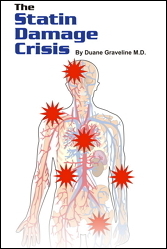Fat and Cholesterol Don't Cause Heart Attacks 3 of 3

By Paul J. Rosch, M.D., M.A., F.A.C.P.
The following is excerpted from the book:
Fat and Cholesterol Don't Cause Heart Attacks And Statins Are Not The Solution
The Tecumseh Community Health Study followed 2,000 men and women for two decades in an attempt to demonstrate that cholesterol levels were influenced by fat consumption in the previous 24 to 48 hrs.
Based on data that included the composition of over 2.700 foods, it concluded that blood cholesterol and triglyceride levels were unrelated to the quality, quantity, or proportions of fat, carbohydrate, or protein consumed. Those who ate the least amount of saturated fat had the highest blood cholesterol levels.
The World Health Organization’s MONICA epidemiologic project was undoubtedly the largest study ever designed to explore the relationship between risk factors and cardiovascular disease. It began in 1971 as a collaborative effort involving 32 centers in 21 countries that monitored approximately 10 million men and women aged 25-64 for ten years.
It thoroughly discredited the saturated fat–heart disease hypothesis. All the countries in the top eight for fat consumption had lower death rates for heart disease than all of the eight countries that consumed the least fat. The French ate three times as much saturated fat as the Azerbaijani but had one-eighth the rate of heart disease deaths.
Such epidemiologic studies cannot disprove the fatty diet –heart disease hypothesis, nor can they prove it, as illustrated by Keys Seven Countries Study. They can only demonstrate whether there is a statistically significant association between the two, which is quite different.
In addition to cholesterol, hypertension and smoking, there are several hundred risk factors that are associated with increased risk for heart disease, including a deep diagonal earlobe crease, premature vertex baldness and abdominal obesity. However, correcting these with plastic surgery, a hair transplant or tummy tuck will not decrease the risk of a heart attack.
It would be more accurate to refer to these as risk "markers", since they have no etiologic role. The only way to prove cause - effect relationships is a randomized clinical trial comparing the effect of restricting fat with a control group that followed their regular diet.
As noted previously, the Prudent Diet study failed to show any such benefits, but it was limited to a relatively small number of middle aged men, and there was little monitoring of what they actually ate. What was required were large scale interventional trials, and these have also failed.
The MRFIT (Multiple Risk Factor Intervention Trial) was the largest and most intensive effort to prove the links between diet, cholesterol and heart disease based on Framingham risk factors.
Between 1973 and 1976, researchers carefully screened over 350,000 men at high risk for heart disease because they had elevated cholesterol, hypertension and smoked cigarettes.
From this group, 12,866 healthy men aged 35 to 57 with no history or evidence of heart disease were enrolled in the study and randomly assigned to either an intervention group that received treatment for all risk factors or a control group that received usual care.
A 1982 8-year follow-up revealed that cholesterol intake had been cut by 42%, saturated fat consumption by 28%, total calories by 21%, and there had been a significant reduction in hypertension and cigarette smoking in the intervention group, compared to usual care controls.
Although there was also a modest fall in serum cholesterol, there was no effect on coronary heart disease and the disappointing conclusion was “The overall results do not show a beneficial effect on Coronary Heart Disease or total mortality from this multifactor intervention."
Paul J. Rosch, M.D., M.A., F.A.C.P.







